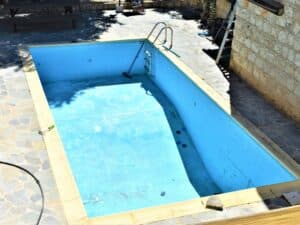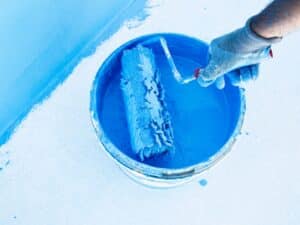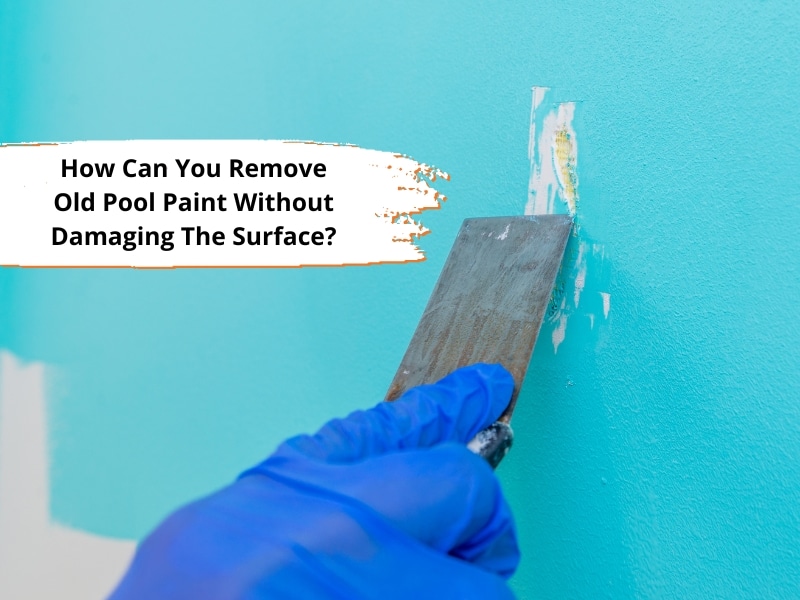Removing old pool paint can seem daunting, especially if you’re worried about damaging the pool surface. Whether you have a concrete or fibreglass pool, the proper techniques ensure safe and effective paint removal, setting the stage for a long-lasting, fresh coat. This guide covers essential steps and expert tips on how to remove old pool paint without damaging the surface.
How can you tell if your pool needs old paint removal?
A few signs indicate it’s time to remove old pool paint before a new layer:
- Faded or discoloured areas: UV rays, pool chemicals, and algae build-up can cause colours to fade or discolour.
- Chipping and peeling: If you see flakes or chipped paint, it’s likely time for removal. Loose paint won’t bond well with a fresh layer.
- Rough texture: A smooth surface is vital to safe swimming and ease of cleaning. Rough patches may signal paint wearing away.
- Frequent algae growth: Older paint can become porous, encouraging algae growth.
What are the risks of removing pool paint yourself?
While DIY can be tempting, removing pool paint yourself comes with risks:
- Surface damage: Without the right tools or techniques, it’s easy to scratch or gouge the pool surface, especially on fibreglass.
- Chemical exposure: Solvents or paint strippers can emit fumes that may be harmful without proper ventilation or safety gear.
- Inadequate removal: Leaving paint remnants can hinder the adherence of new paint, leading to premature peeling.
- Environmental concerns: Old paint waste, particularly lead-based, must be disposed of safely to avoid environmental harm.
What tools and techniques are used for safe pool paint removal?
Professionals use various tools and methods to remove paint without harming the surface while adhering to local pool fence requirements and safety regulations.
- Pressure washing: A low-pressure wash can remove loose, flaking paint without scraping the pool surface.
- Sanding: Sanding may be necessary to smooth rough spots or where paint has sincerely adhered, especially with epoxy layers.
- Chemical Strippers: Eco-friendly strippers are applied to dissolve paint safely. For more rigid coatings, these work well without damaging the surface.
- Blasting Techniques: Media blasting, like soda blasting, uses a gentle abrasive to strip paint. This method is ideal for concrete pools, as it’s effective but gentle.
How can you prepare your pool for the paint removal process?
Proper preparation is crucial for a smooth paint removal process:
- Drain the pool: Make sure the pool is thoroughly drained and dry. This allows better access and visibility for any surface prep.
- Clean the surface: Remove debris, leaves, and algae. This step ensures that dirt doesn’t interfere with the paint removal.
- Repair minor cracks: Filling in small cracks helps avoid worsening damage during the removal process.
- Cover surrounding areas: Use protective coverings around the pool to prevent damage from chemicals or stray paint chips.
Which method is best for removing paint on different pool surfaces?
Different pool surfaces require tailored methods to avoid damage:
- Concrete pools: Pressure washing and soda blasting are effective on concrete. These methods reach stubborn paint layers without gouging.
- Fibreglass pools: Sanding and chemical strippers are best for fibreglass pools, as they can be easily scratched. A mild approach avoids compromising the surface.
- Plaster or pebblecrete pools: Media blasting works well on these textured surfaces. It ensures thorough paint removal without the risk of uneven patches.

How do you ensure no damage to the surface during paint removal?
Using the proper methods and protective techniques will ensure a damage-free paint removal process:
- Low-pressure settings: High-pressure washing may seem effective but can erode the surface, especially for softer materials.
- Testing chemicals: Always test strippers on a small, inconspicuous area to check for any adverse reactions.
- Controlled sanding: Use fine-grit sandpaper and avoid excessive force, particularly on fibreglass.
- Professional assistance: Experienced professionals know how to handle different surfaces, applying safe techniques for flawless results.
Can paint removal reveal issues with the pool surface?
Paint removal can sometimes reveal underlying issues that might otherwise go unnoticed:
- Cracks and chips: Tiny cracks or chips may be hidden under old paint. Addressing them now ensures a smooth, long-lasting repaint.
- Uneven surface texture: Blotchy or rough patches signal uneven surface wear that may need smoothing.
- Water damage: Signs of water damage, such as discolouration or staining, could indicate leaks. Fixing them before repainting can prevent future issues.
What are the benefits of applying new paint after removal?
Once the old paint is removed, a fresh layer can transform your pool:
- Enhanced aesthetics: New paint can brighten and revive your pool, giving it a clean, attractive look. However, it’s important to weigh the pros and cons of DIY pool painting before diving in.
- Improved durability: Quality pool paint protects against sun, chemicals, and wear. Reapplying after removal extends the lifespan of your pool surface.
- Easy maintenance: A freshly painted pool resists algae, is easier to clean, and maintains its appearance longer.

Why should you choose professional painting services for your pool?
Professional pool painting services offer advantages that DIY often cannot match:
- Expertise: Professionals understand the nuances of different pool types and use the best methods to avoid damage.
- Efficient techniques: Using industry-grade equipment, professionals ensure a thorough and time-efficient job.
- High-quality paint products: Quality paint products add a polished finish and durability, making them suitable for Australian conditions.
- Long-term results: Professionals specialising in painting a fibreglass pool focus on long-lasting results, ensuring your pool remains beautiful and durable for years.
How can you maintain the freshly painted pool surface for longevity?
With a newly painted pool, a few simple maintenance practices will keep it looking fresh:
- Regular cleaning: Brush and clean the surface weekly to prevent algae and grime build-up.
- Balance pool chemistry: Keep pool chemicals at appropriate levels to avoid fading or damage to the paint.
- Monitor water levels: Maintain consistent water levels to prevent exposing paint to excessive sun and air, which can cause cracking.
- Seasonal inspections: Have a professional check for any wear and tear each season. Prompt repairs prevent minor issues from worsening.
Enhance your pool’s look with Sydney Paintmasters!
If you’re ready to transform your pool with a fresh coat of paint, Sydney Paintmasters offers expert services to guide you every step of the way. From safe paint removal to applying the perfect finish, our experienced team ensures your pool is in top shape. With top-quality paints and techniques designed to withstand Sydney’s climate, you’ll enjoy a vibrant, long-lasting pool. Contact Sydney Paintmasters today for a consultation, and let us make your pool the star of your backyard.

